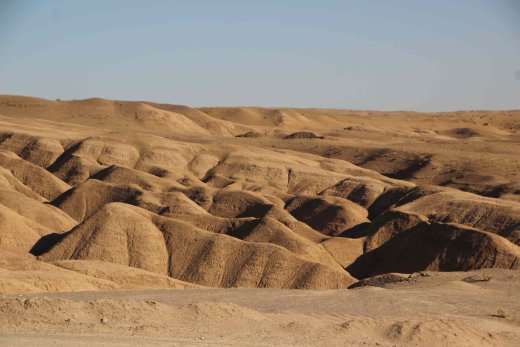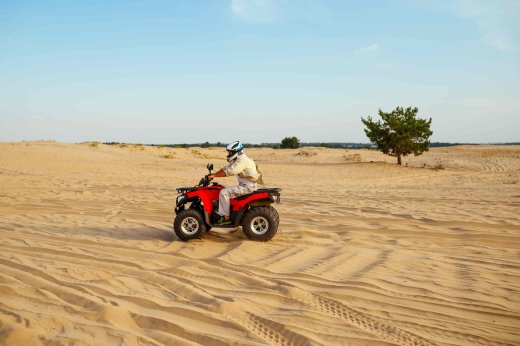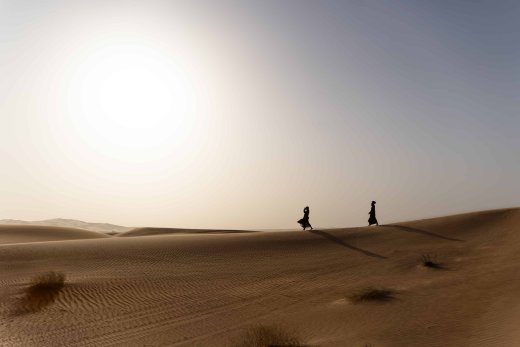
Exploring the Fossil Dunes of Abu Dhabi How These Ancient Landscapes Offer Clues to Life on Mars
Hidden in the Al Wathba in Abu Dhabi, the Fossil Dunes are more than just a striking geological phenomenon. The surreal, wind-sculpted rock formations are an otherworldly experience for visitors — and an unlikely crossroads for planetary science. As scientists grapple with the search for life on Mars, the Fossil Dunes Abu Dhabi are emerging as a key reference point to understand how similar formations may have formed on the Red Planet.
In this article, let’s see how these ancient landscapes were created, why they are important to scientists and what they hint at for the potential for life on Mars.
What Are the Fossil Dunes Abu Dhabi?
The Fossil Dunes are 45 minutes from Downtown Abu Dhabi. This sandstone feature has been carved into this formation over millions of years by wind, water, and climate change, as evident from its sedimentary sandstone figures. The dunes are mostly calcium carbonate, bonded together by salt crystals and minerals blown by the desert wind.
What makes these structures so remarkable is their intricate sculptural nature. It features curved ridges, hollow arches and towering spires. In 2022, the Al Wathba Fossil Dunes Protected Area was opened for the public, complete with walkways, guides and an educational centre.
How Were the Fossil Dunes Formed?
Abu Dhabi’s fossil dunes were created in a rare combination of blowing sand, humidity and mineral-laden groundwater during the Ice Age. Minerals, such as calcium sulfate and quartz, bonded with loose sand as the ancient lakes and wetlands that once covered the region dried up, gradually solidifying into rock.
The frequent wind has over many years eroded these solid formations into elaborate designs; especially the Shamal, a northwesterly wind of the region. The result is a landscape of delicate sculpture that feels more like something out of a sci-fi movie set than part of the Earth’s natural desert.
Why Are Scientists Interested in the Abu Dhabi Fossil Dunes?
These dunes are not just beautiful to look at in photographs. Instead, they’re also scientifically significant for Astrobiology. Abu Dhabi’s Fossil Dunes have captured the attention of NASA, the UAE Space Agency, and multiple institutions of higher education for their similarities to the geology of Mars. But why? Let’s understand here.
1. Similar Formation Processes
Mars has large regions dominated by sedimentary rocks and dunes, both of which appear to have been shaped by wind, and perhaps by water, in the past. The forces that sculpted the Fossil Dunes, as well — wind erosion, cementing of grains, sedimentation — are the same those suspected on Mars.
By exploring how dunes were shaped and destroyed on Earth, scientists can develop more accurate models of Martian terrain.
2. Microbial Clues
While life has yet to be found on Mars, scientists look for biosignatures. So these are the signs that microbial life could have existed in the past. The Fossil Dunes Abu Dhabi provides a terrestrial analogue. Some geologists have believed that the dunes might have served as a home to microbial mats in the ancient past, which could have left chemical imprints on the rock. That makes the Fossil Dunes a useful testing ground for instruments and techniques being developed for exploring Mars and finding signs of ancient life.
3. Extreme Environments and Adaptations
The UAE’s harsh desert weather mimics the environmental conditions of Mars. So this includes sudden temperature changes, high salinity, and low moisture. By examining how rock forms and the ability to support microbial life under those conditions, researchers learn more about the habitability of Mars.
What You’ll Experience Visiting the Fossil Dunes?
In addition to their scientific significance, the Fossil Dunes at Abu Dhabi make a great place for nature enthusiasts, photographers, and families. The protected area offers:
- Boardwalks and viewpoints to reduce habitat disturbance.
- Nighttime lighting is used to maximize the attractiveness of the formations after dark.
- Informational signs on the geology and history, and significance of the dunes.
- Eco-tours led by an expert for another take on desert ecology.
The venue also provides shaded seating and food trucks. Hence, you can have an easy and enjoyable day trip from the capital city of Abu Dhabi.
Fossil Dunes and Responsible Tourism
The UAE has taken major steps to protect these fragile formations. Visitors to the Abu Dhabi Fossil Dunes must stay on marked trails and to avoid climbing on the dunes and disturbing wildlife. This ensures that the site remains safe for tourists, the wildlife, and also for scientific study.
Besides that, the development of this area into a tourist site is a thoughtful step, combining both tourism and conservation. It is a model on how to turn a natural heritage into a source of scientific discovery and sustainable tourism.
A Window into Earth’s and Mars' Past
In some ways, the Fossil Dunes Abu Dhabi are both a time machine and a telescope. They provide a close-up view of ancient Earth’s climate and resemble the kinds of terrain now being explored on Mars.
To geologists, astrobiologists, and planetary scientists, though, these formations are not just static rocks — they are dynamic clues to the universe’s history. It is an integral part of Astrobiology. Moreover, for tourists, they have a rare chance to stroll through a landscape that seems quite unreal.
Conclusion
The Fossil Dunes Abu Dhabi weaves together space, science, nature, and the human spirit of discovery. These natural works of sculpture are more than mere historical structures. Instead, they help solve the mystery of our planet and even Planet Mars. So if you are a curious traveller, a fan of Geography, or just love to discover about space, this ancient place is sure to be on your itinerary.
Are you planning a trip to Abu Dhabi and looking for customized tour packages? Then, Visitors Destination offers you the best tour packages for a memorable vacation. Book your packages today or contact us for package customization.
Frequently Asked Questions
1. What are the Fossil Dunes of Abu Dhabi made of?
The Fossil Dunes consist of calcium carbonate and sand, which had been created over millions of years. Mineral content in the water from the groundwater combined with the sand particles and wind erosion created the patterns found today.
2. Why are scientists comparing the Fossil Dunes to landscapes on Mars?
The formations have geological resemblances to sedimentary features on Mars, such as wind-carved dunes and mineral-rich layers. Studying the Fossil Dunes allows scientists to learn about potential sites for life and other conditions on Mars.
3. Where are the Fossil Dunes located in Abu Dhabi?
The Fossil Dunes Abu Dhabi fossil dunes are in the Al Wathba area. It is about 45 minutes from the Abu Dhabi city centre. The site is within the Fossil Dunes Protected Area and is publicly accessible.
4. When is the best time to visit the Fossil Dunes Abu Dhabi?
You can consider visiting the Al Wathba Fossil Dunes during the winter season, which runs from October to April.
5. How old are Abu Dhabi's Fossil Dunes?
The dunes date to the Ice Age, aging them to be an estimated 120,000 to 140,000 years old. They took shape during fluctuations in the climate that allowed mineral-laden groundwater to turn desert sand into stone.












